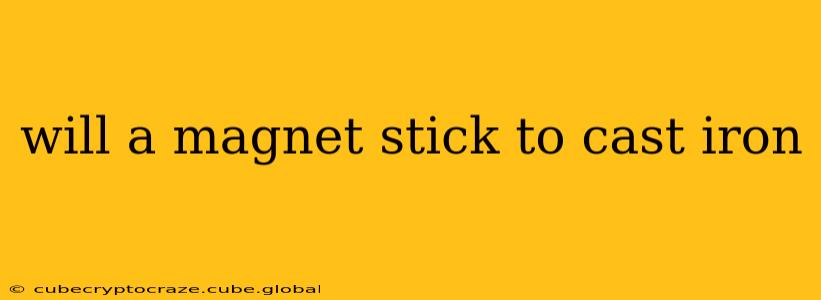Yes, a magnet will generally stick to cast iron. This is because cast iron is a ferromagnetic material, meaning it contains iron and can be magnetized. However, the strength of the magnetic attraction will depend on several factors, which we'll explore in detail below. Understanding these factors helps determine whether a magnet will stick strongly, weakly, or not at all.
What Makes Cast Iron Magnetic?
Cast iron is an alloy primarily composed of iron, carbon, and silicon. The high iron content is the key to its magnetic properties. Iron atoms possess a property called "magnetic moment," meaning they act like tiny magnets. In most materials, these atomic magnets are randomly oriented, cancelling each other out. However, in ferromagnetic materials like iron, these atomic magnets tend to align, creating a macroscopic magnetic field. This alignment is what allows cast iron to be attracted to magnets.
Factors Affecting Magnetic Attraction to Cast Iron
Several factors influence how strongly a magnet adheres to cast iron:
1. The Type of Magnet:
- Neodymium magnets (NdFeB): These are the strongest type of permanent magnet readily available and will almost certainly stick to cast iron, often quite strongly.
- Ferrite magnets (ceramic magnets): These are less powerful than neodymium magnets but are still strong enough to attract cast iron, though perhaps with less force.
- Alnico magnets: These magnets are also capable of attracting cast iron, falling somewhere between ferrite and neodymium in strength.
- Electromagnets: These magnets, powered by electricity, can generate a very strong magnetic field and would strongly attract cast iron.
2. The Strength of the Magnet:
A stronger magnet will naturally exert a greater attractive force on the cast iron than a weaker one. The size and shape of the magnet also influence its strength. Larger magnets generally have a greater magnetic field and therefore a stronger pull.
3. The Composition of the Cast Iron:
The exact composition of the cast iron can affect its magnetic properties. Variations in carbon content and the presence of other alloying elements can slightly alter the magnetization response. Generally, though, the differences are minor unless dealing with specialized cast iron alloys.
4. The Surface Condition of the Cast Iron:
A coating or layer of paint, rust, or other material on the cast iron surface can reduce or even prevent magnetic attraction. The magnetic field needs to penetrate the surface to interact with the iron atoms within.
5. The Temperature:
The Curie temperature is the temperature above which a ferromagnetic material loses its magnetism. For iron, this is around 770°C (1418°F). While unlikely in most everyday scenarios, very high temperatures could affect the magnetic interaction between a magnet and cast iron.
Why Might a Magnet Not Stick to Cast Iron?
While unusual, there are a few situations where a magnet might not seem to stick to cast iron:
- Extremely weak magnet: A very small or weak magnet might not be able to overcome the friction or other forces preventing adhesion.
- Thick non-magnetic coating: A thick layer of paint, rust, or other non-magnetic material could completely block the magnetic field.
- Extremely high temperature: As mentioned above, exceeding the Curie temperature would make the cast iron non-magnetic.
- Presence of other strong magnetic fields: Competing magnetic fields could interfere with the attraction between the magnet and cast iron.
Will a magnet stick to all types of iron?
While cast iron is magnetic due to its high iron content, it's worth noting that not all forms of iron are equally magnetic. Pure iron is highly magnetic, but other iron alloys or compounds might exhibit varying degrees of magnetic attraction, or none at all. The presence of other elements can significantly alter magnetic properties.
In conclusion, a magnet will generally stick to cast iron, but the strength of the attraction depends on several interacting factors. Understanding these factors allows for better prediction and control of magnetic interactions with cast iron.
